What is the Best Time to See Northern Lights in Iceland in 2024?
If the ethereal beauty of the aurora borealis, or Northern Lights, is on your bucket list, Iceland in 2024 might be your perfect destination. The country’s pristine landscapes provide an ideal backdrop for this natural light display, a spectacle that has inspired awe and wonder for centuries.
This comprehensive guide will help you plan your trip, providing insights on the best times, places, and ways to marvel at the Northern Lights in Iceland. From understanding the science behind the phenomenon to leveraging technology in your aurora hunt, we’ve got you covered. So read on, and prepare for an unforgettable Icelandic adventure in 2024!
What Are the Northern Lights?
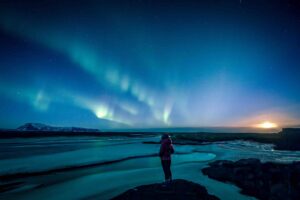
The Northern Lights, also known as Aurora Borealis, are a stunning natural phenomenon that illuminates the night sky with an ethereal glow.
What Causes the Northern Lights?
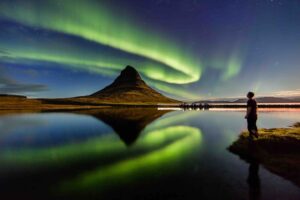
This spectacle occurs when particles from the sun, known as solar wind, interact with the Earth’s magnetic field. The solar winds are full of electrons and protons. When these charged particles enter the Earth’s atmosphere, they collide with atoms and molecules of oxygen, nitrogen, and other elements, causing them to ‘excite’ and emit photons – light particles.
The different colours of the Northern Lights are a result of these interactions with various gases in the Earth’s atmosphere. Green, the most common colour observed, is produced by collisions with oxygen molecules located about 60 miles above Earth. Higher altitude oxygen collisions, around 320 kilometres or 200 miles above our planet, can produce a rare red aurora. On the other hand, interactions with nitrogen produce blue or purplish-red auroras.
In simpler terms, think of the Northern lights as a colossal, celestial neon light. The sun provides the electricity in the form of solar wind, the Earth’s atmosphere acts as the neon gas, and our magnetic field serves as the guiding pathway, creating a luminous display for us to marvel at.
What Are the Best Months to Visit Iceland to See the Northern Lights?
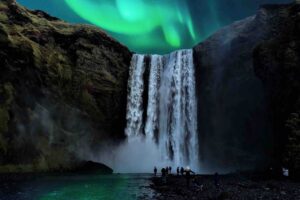
The best time to see the Northern Lights in Iceland is during the darker months of the year, typically between September and April. During this period, the skies are the darkest, which provides a better contrast for the lights, making them easier to spot. The winter solstice, which occurs around December 21, experiences the longest nights, hence offering the longest window of opportunity to view the lights.
However, the weather in Iceland is notoriously unpredictable, and clear skies are a must for a successful aurora hunt. Therefore, while you can see the lights anytime between late fall and early spring, the months of October, February, and March are often cited as the most favourable due to their relatively stable weather conditions. But remember, seeing the Northern Lights is never guaranteed and requires a bit of luck and patience.
What Conditions Do You Need to See the Northern Lights in Iceland?
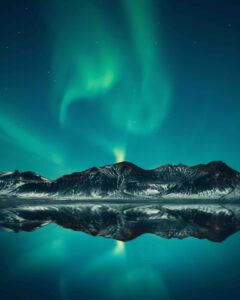
The Northern Lights are technically present in the Earth’s atmosphere at all times but there needs to be a specific set of conditions in order to view them with the human eye. The required conditions to see the Aurora Borealis are listed in more detail below.
Clear Skies
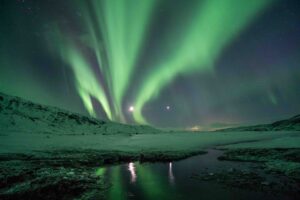
Clear skies play an essential role in viewing the Aurora Borealis. The Northern Lights manifest themselves high up in the Earth’s atmosphere, between 90 to 320 kilometres or 60 to 200 miles above the surface. Thus, any cloud cover can obstruct the view entirely, as if hiding a theatre screen from an audience.
Even if the auroral activity is strong, dense clouds can render the vibrant lights invisible to observers on the ground. Consequently, the first rule in your aurora hunt is to find a night when the skies are as clear as possible. Moreover, clear skies also allow for better photographic opportunities, enhancing the color and clarity of your pictures. So, for an optimal Northern Lights experience in Iceland, always check the weather and cloud forecast.
Darkness
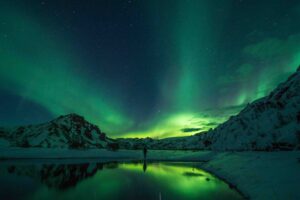
The presence of darkness is paramount for a successful Northern Lights sighting. As the auroras are a form of natural light, their visibility greatly increases under darker conditions, which provide a stark contrast, allowing the colours to pop out. This is why they are seldom spotted during daylight hours or in places with high light pollution, such as urban centres. Even the moon, if full and bright, can somewhat diminish the intensity of the Northern Lights. In Iceland, long winter nights with little to no moonlight offer the best chances to witness this celestial spectacle in all its glory. Therefore, when planning your Northern Lights trip, try to aim for moonless nights, and choose viewing locations far from city lights, where the natural darkness will make the auroras seem even more vibrant and awe-inspiring.
Solar Activity
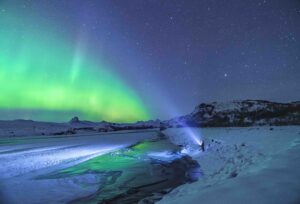
Another critical factor that determines the visibility of the Northern Lights is the level of solar activity. The Sun constantly emits a stream of electrically charged particles known as solar wind. The intensity of these emissions fluctuates, with periods of heightened solar activity resulting in stronger winds. When these stronger winds reach Earth, they can cause more intense and frequent displays of the Northern Lights. Therefore, keeping track of solar activity can significantly improve your chances of spotting the auroras.
One popular tool used to measure geomagnetic activity is the Kp index. The Kp index ranges from 0 to 9, with 0 signifying very little geomagnetic activity and 9 indicating a geomagnetic storm. The higher the Kp index, the further from the poles the Northern Lights can be observed. On nights with a high Kp index, the Northern Lights might be visible even in regions that usually don’t experience this phenomenon.
In the context of a Northern Lights hunt in Iceland, a Kp index of 2 or 3 is often sufficient to see the lights, given the country’s high latitude. However, a higher Kp index may result in more vibrant and dynamic auroral displays.
There are several websites and apps where you can check the predicted Kp index for your Northern Lights trip. By monitoring this index, along with the weather forecast and the level of darkness, you can determine the best time and location for your aurora hunt. Just remember, while these tools can help improve your chances, seeing the Northern Lights is never guaranteed and is always a thrilling gift from Mother Nature.
And…Patience!

Patience is an essential virtue when hunting for the Northern Lights, primarily due to their unpredictable nature. The lights are a product of numerous factors aligning perfectly – clear skies, darkness, and heightened solar activity. Even with these conditions met, there is no guarantee that the lights will appear at a specific time. They can show up early in the evening, in the middle of the night, or not at all.
Auroras also vary in duration, with some displays lasting a few minutes and others several hours. Waiting for this natural spectacle can be a test of endurance, particularly in the cold, icy conditions of an Icelandic winter night. However, the rewards of witnessing the celestial dance of lights across the dark sky make every minute of the wait worthwhile. So bring plenty of warm clothes, a thermos of hot drink, and a healthy dose of patience – it’s all part of the unforgettable adventure of hunting for the Northern Lights in Iceland.
What Months Give Me the Best Chances to See the Northern Lights in Iceland?
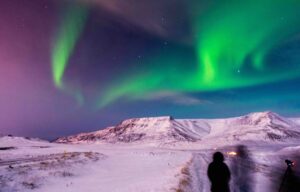
In Iceland, the Northern Lights can be seen from late September to early April. However, the months of September and March, known as the equinox months, are often cited as the optimal time to witness this celestial spectacle. The reason for this is due to the balance between dark nights and relatively mild weather, presenting ideal conditions for aurora viewing.
During the equinox, the Earth’s magnetic field aligns more directly with the solar wind – the stream of charged particles that cause the Northern Lights. This alignment increases the likelihood of experiencing auroral activity. Notably, historical patterns over the past five years consistently show a spike in Northern Lights sightings during these equinox months.
In September 2019, for instance, there were several nights of high auroral activity, providing stunning displays across the Icelandic skies. Similarly, in March 2020, the auroras put on an exceptional show, with multiple nights of high intensity, colourful lights. Data for the years leading up to these also indicate a higher frequency and intensity of auroras during the equinox months.
While the Northern Lights are a natural phenomenon and their appearance can never be guaranteed, statistics from recent years prove that planning your trip in September or March can significantly increase your chances of experiencing this natural wonder. Remember though, whatever the time of year, the aurora hunt requires patience, luck, and a love for adventure.
What is the Best Time of Day to See the Northern Lights in Iceland?
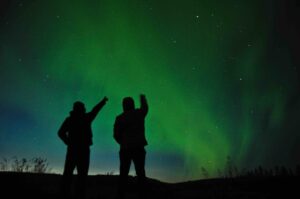
The Northern Lights, due to their dependence on darkness, are most active and visible during late evening to early morning hours, typically from 9:00 PM to 2:00 AM. This is when the sky is at its darkest and provides the best backdrop for the lights to clearly stand out. However, there’s no precise “golden hour” for Northern Lights viewing since it largely depends on solar activity and local weather conditions. Hence, enthusiasts are advised to stay alert and patient throughout the night. Some prefer to rest early and set alarms to wake up at different intervals, while others find the anticipation too exciting and choose to stay awake, immersing themselves in the calm and beauty of Iceland’s night sky as they wait for the magical light show to unfold.
Where Are the Best Places to See the Northern Lights in Iceland?
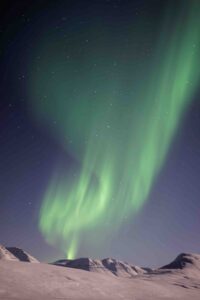
There are very few (if any) places in Iceland that have never been the setting for a display of the Aurora Borealis so realistically, you can see them just about anywhere in the land of fire and ice. However, as a general rule, it’s a good idea to get away from light pollution to give yourself the best chance of witnessing this phenomenon. If you would like to make your Northern Lights experience the best it could possibly be; it‘s a good idea to choose a spectacular backdrop as the location for your hunt. A few great suggestions are listed below.
1. The Golden Circle
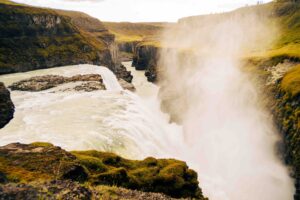
The Golden Circle is one of the most popular tourist routes in Iceland, renowned for its spectacular natural attractions comprising of three primary stops: the Þingvellir (Thingvellir) National Park, the Geysir Geothermal Area, and the Gullfoss Waterfall. The route’s relatively close proximity to Reykjavík makes it an accessible journey for travellers.
Þingvellir National Park, a UNESCO World Heritage site, is a place of immense natural beauty and historical significance. It’s not just the home of Iceland’s first parliament, but also a spot where you can literally walk between continents, as it’s the meeting point of the North American and Eurasian tectonic plates.
The Geysir Geothermal Area is a hotbed of geysers and hot springs, including the Great Geysir – the namesake of all geysers globally – and its more active neighbour, Strokkur, which erupts every 5-10 minutes.
Lastly, Gullfoss, or the ‘Golden Falls’, is a stunning waterfall that plunges into a deep gorge, creating a rainbow-filled mist on sunny days that adds to its ethereal beauty.
Hunting for the Northern Lights in the Golden Circle is a magical experience. The lack of light pollution, coupled with the stunning natural backdrop, provides an ideal setting for viewing the Aurora Borealis. Imagine watching the dancing lights reflecting off the surface of the geysers or illuminating the sky above the stunning Gullfoss falls. These extraordinary sights make the Golden Circle an excellent choice for your Northern Lights adventure in Iceland.
2. Snæfellsnes Peninsula
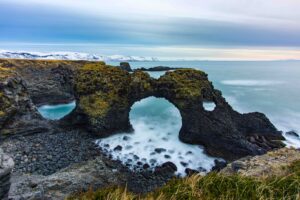
The Snæfellsnes Peninsula, often dubbed ‘Iceland in Miniature’, is a region that encapsulates all that is enchanting about Iceland’s diverse landscapes in one small area. Dominated by the majestic Snæfellsjökull glacier, the peninsula is teeming with dramatic cliffs, black and golden sand beaches, charming fishing villages, and ancient lava fields. The region is also a haven for birdwatchers, hosting numerous species, including puffins and eagles.
The Snæfellsnes Peninsula’s remote location away from city lights makes it an exceptional place to view the Northern Lights. With a clear sky, the vibrant auroras can be seen dancing over the glacier, creating a mesmerising spectacle that marries the earthly and the celestial. The tranquil surroundings and the spectacular natural backdrops make the Snæfellsnes Peninsula a dream location for hunting the Northern Lights.
3. Mývatn
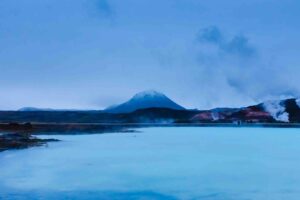
Mývatn, situated in the northern part of Iceland, is a geothermal wonderland known for its rich biodiversity and surreal lunar-like landscapes. The region is named after Lake Mývatn, which translates to ‘Midge Lake’, owing to the swarms of midges that inhabit the area during summer. The lake itself is a haven for birdwatchers, hosting various species, especially ducks, attracted by the wealth of aquatic insects and plants. Surrounding the lake are fascinating geothermal features, including the Dimmuborgir lava formations, the Hverir mud pools, and the Krafla volcano.
The area’s remote location and low light pollution make Mývatn an exceptional spot for Northern Lights viewing. Imagine observing the auroras casting their ethereal glow on the steamy hot springs or reflecting off the tranquil surface of the lake – a truly mesmerising experience. The combination of its unique natural features and optimal aurora-viewing conditions indeed make Mývatn a captivating choice for Northern Lights hunters in Iceland.
4. All Around Iceland
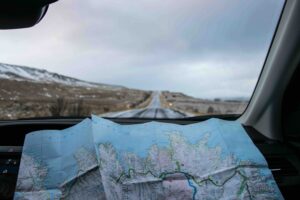
While the locations mentioned above are popular and provide a spectacular backdrop for viewing the Northern Lights, one of the unique aspects of this awe-inspiring spectacle is that it can be seen from just about anywhere in Iceland, provided conditions are favourable. Whether you’re stationed in Reykjavík, driving along the Ring Road, or nestled in a remote cabin in the Westfjords, you have a chance to witness this celestial dance. Even near city centres where light pollution is typically an issue, on a strong Aurora night, you might catch glimmers of the lights. That said, the darker the location, the better your viewing experience would be. So, while planning your trip, it’s beneficial to include a mix of city explorations and remote escapes to ensure the best chances of witnessing and fully appreciating the Northern Lights in all their glory.
What Are the Best Apps to Use When Searching For the Northern Lights?
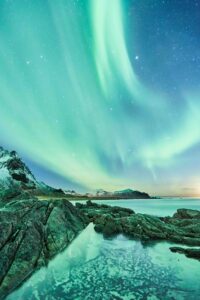
There are several apps available that can significantly aid your Northern Lights hunting experience by providing alerts, forecasts, and tips. Some notable options include:
1. Aurora Forecast & Alerts
This app provides real-time aurora borealis forecast with alerts for when the KP index is high enough for a potential sighting. It also includes a cloud cover map, which can be crucial for locating clear skies.
2. My Aurora Forecast
A solid choice for iOS users, it provides forecasts of when and where the Northern Lights are likely to appear, alerts for when they’re visible in your location, and a handy countdown timer for the next aurora.
3. Hello Aurora App
Specifically designed for Iceland, this app provides alerts and a real-time aurora forecast map for Iceland, helping you know the best time and place to see the Northern Lights in this spectacular destination.
Do Any Hotels Help Visitors to See the Northern Lights in Iceland?
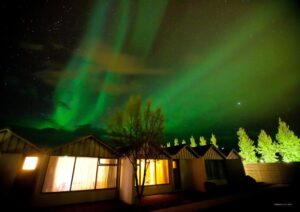
Many hotels in Iceland understand the allure of the Northern Lights for their guests, and thus, they offer services to assist visitors in their quest to witness this mesmerising spectacle. These services can range from providing information on the best locations and times, to arranging guided tours, and even setting up wake-up calls for when the Northern Lights make their appearance (active until 11pm each evening).
One such hotel that goes above and beyond is the Hill Hotel in Flúðir. Nestled in a serene location that’s far from intrusive city lights, Hill Hotel capitalises on its unique positioning to offer an unforgettable Northern Lights experience to its guests.
The hotel arranges guided Northern Lights tours, providing guests with the chance to experience the ethereal beauty of the Aurora Borealis against the backdrop of Iceland’s pristine wilderness. Furthermore, the hotel staff make a point to alert guests whenever the Northern Lights make an appearance, ensuring that you won’t miss out on the opportunity to witness this celestial show even if you’re enjoying the comfort of the hotel. By taking care of the logistics and providing local expertise, Hill Hotel allows its guests to wholly focus on the exhilarating experience of witnessing the Northern Lights.
What Are the Best Northern Lights Tours Available?
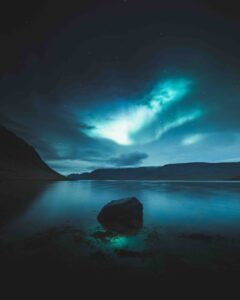
In Iceland, you’ll find a plethora of Northern Lights tours to choose from, each offering unique experiences that cater to different preferences and budgets. Here’s a brief description of three of the best value Northern Lights tours available:
This tour offers an exciting exploration of the Icelandic countryside by night, in a quest to find the elusive Northern Lights. The journey begins with a drive away from the light pollution of the city, followed by a stop at a remote location where you’ll have a chance to witness the spectacular auroral show.
This tour takes you on an adventure through the darkness of the Icelandic wilderness. You’ll be guided by an experienced local who will share fascinating folklore and facts about the Northern Lights, making the experience not just visually stunning but also culturally enriching.
For a truly unique experience, this tour takes you out to the open sea, away from city lights, providing a serene environment to experience the Northern Lights. The tour includes warm overalls, a guided tour, and access to a stargazing guide, making it a comprehensive package for a memorable night under the Icelandic sky.
There are even more tours available here. Remember to book in advance and check the weather conditions for the best possible experience.
Conclusion
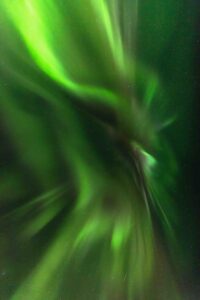
In conclusion, Iceland is undoubtedly one of the best places in the world to witness the Northern Lights. With its stunning natural landscapes and a range of accommodation and tours available, it’s no wonder that it attracts visitors from all over the globe who are eager to experience this awe-inspiring phenomenon. Happy hunting!

